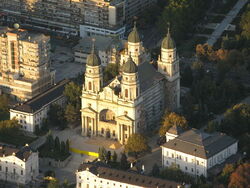
View from above
The Metropolitan Cathedral, Iaşi (Romanian: Catedrala Mitropolitană din Iaşi), located at 16 Ştefan cel Mare şi Sfânt Boulevard, Iaşi, Romania, is the seat of the Romanian Orthodox Archbishop of Iaşi and Metropolitan of Moldavia and Bukovina. It is dedicated to Saint Paraschiva, to the Presentation of Jesus and to Saint George. Its form was inspired by the late Italian Renaissance style (Trinità dei Monti in particular), with Baroque elements dominating the interior and exterior decorative features.[1]
Two churches previously stood on the site: the White Church (15th century) and the Presentation Church (17th century). On 8 August 1826, prince Ioan Sturdza signed a decree ordering construction of the cathedral; Metropolitan Veniamin Costachi laid the cornerstone on 3 July 1833 and guided construction in its early years. Work began in 1833, using a neo-classical design by Viennese architects Johann and Gustav Freiwald, and continued at a rapid pace until 1841, in the latter years under the Russian architect Sungurov. Construction stopped in 1842 when Veniamin had to retire. In 1839, serious cracks had appeared on the large central arch, which collapsed on 23 May 1857, taking the interior columns with it. Various solutions were attempted (in 1840 Sungurov replaced the brick ceiling with wood, for example), but the building remained unfinished for almost four decades.[2]
At the urging of Metropolitan Iosif Naniescu (1875-1902), the newly-independent Romanian state decided to resume work on the cathedral. A new cornerstone was laid on 15 April 1880. Alexandru Orăscu, rector of the University of Bucharest, designed new plans that added two rows of massive pilasters to the interior, creating a rectangular basilica shape, with a central nave and two smaller side naves. The four detached side spires were kept, but the large central dome was eliminated and replaced with a system of four semicircular sections, separated by transverse arches.[2]
Gheorghe Tattarescu painted the icons and decorative elements in a style that respected Orthodox norms but also showed a Renaissance influence. The four Biblical scenes above the central nave, the saints' faces and the decorative compositions all show an Italian neo-classical rigor, to which the artist had been exposed during his studies at Rome's Accademia di San Luca. This creates harmony between the painting and the architectural style.[2] The stained glass was worked in Munich and redone after World War II, under Metropolitan Justinian Marina.[3] Two valuable icons painted in the 16th century are kept inside; they depict Christ Pantocrator and the Madonna and Child. The eastern façade has six columns on a high stone base, above which is a high bas-relief of the Presentation. The western façade has eight columns separated by the entrance, above which is a curved mosaic also showing the Presentation; above that is a stone carving of Saint George. The roof is decorated with zinc fleurons and stylized crosses adorn both the roof and the four spires.[1]
The cathedral was completed in 1887 and consecrated on 23 April that year in the presence of King Carol I and Queen Elisabeth, who had donated large sums for the project. In 1889, the relics of Saint Paraschiva, patron saint of Moldavia, were brought from Trei Ierarhi Monastery and continue to attract crowds of pilgrims, particularly on her feast day (October 14). These are located on the right side of the vestibule, as are those of Veniamin Costachi.[2]
Gallery[]
Notes[]
External links[]
- (Romanian) Catedrala Mitropolitană din Iaşi, Metropolis of Moldavia and Bukovina
- (Romanian) Obiectiv turistic: Catedrala Mitropolitană
- (Romanian) Mitropolia Moldovei şi Bucovinei, Iaşi City Hall
- (Romanian) Catedrala Mitropolitană din Iaşi, crestinortodox.ro
- (Romanian) Centrul de Pelerinaj "Sf. Parascheva"
Coordinates: 47°09′41″N 27°34′56″E / 47.16149°N 27.58210°E


